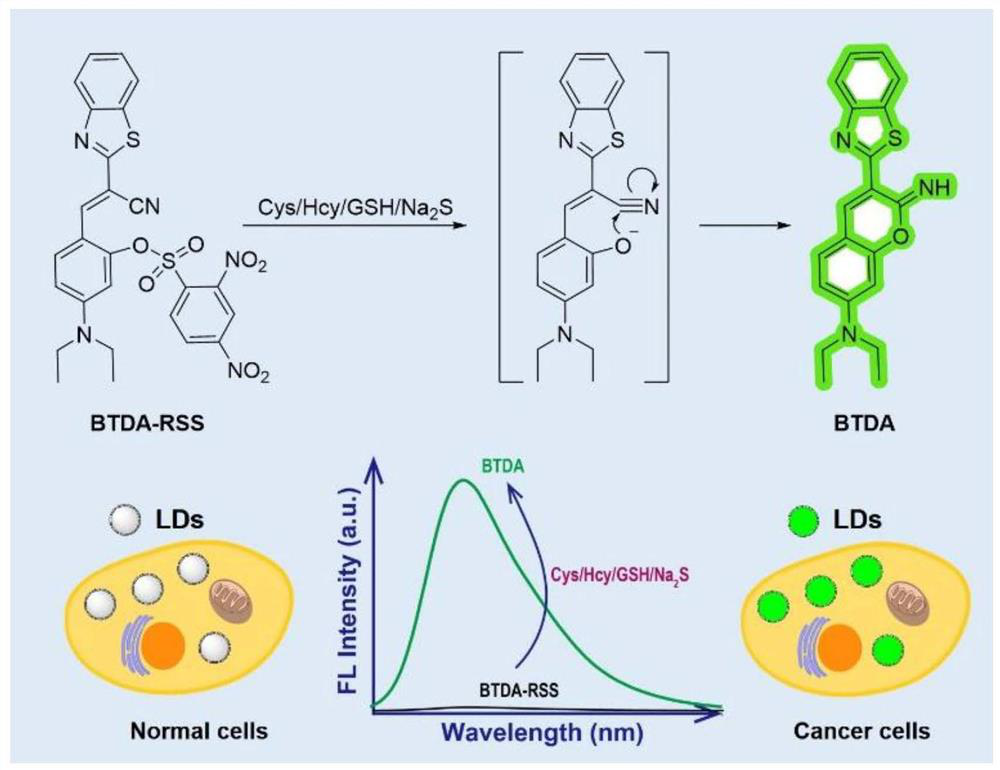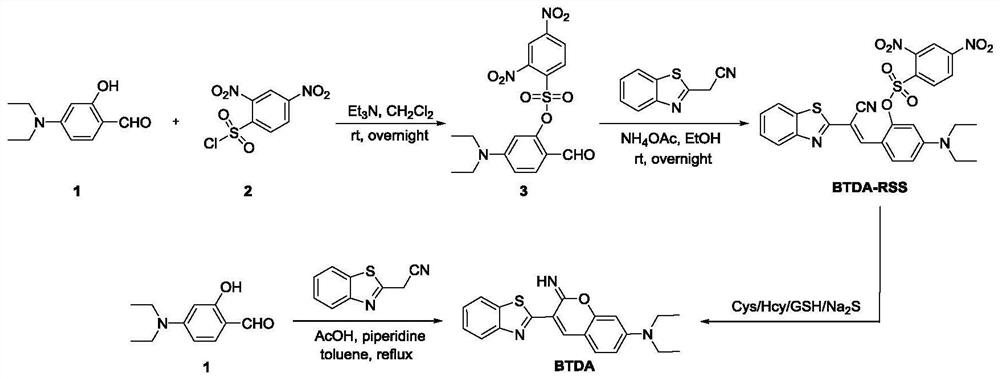Lipid droplet targeting and biological thiol sensitive fluorescent probe for cancer cell tissue diagnosis and preparation and application thereof
A technology for fluorescent probes and cancer cells, applied in the field of organic fluorescent probes and fluorescent probes, can solve problems such as the connection that has not yet been reported, and achieve the effects of superior LDs targeting ability, concise synthesis route, and simple operation.
- Summary
- Abstract
- Description
- Claims
- Application Information
AI Technical Summary
Problems solved by technology
Method used
Image
Examples
Embodiment 1
[0039] Example 1 Preparation of lipid droplet targeting and biothiol-sensitive fluorescent probes for cancer cell tissue diagnosis
[0040] A method for preparing a lipid droplet-targeted and biologically thiol-sensitive fluorescent probe for cancer cell tissue diagnosis. The synthetic route is as follows figure 2 As shown, the specific synthesis steps are:
[0041] Step S1, compound 1 (20 mg, 0.10 mmol) was dissolved in DCM (1 mL) at 0°C, compound 2 (40 mg, 0.15 mmol) was added, followed by Et 3 N (24 μL, 0.16 mmol); the resulting solution was stirred at room temperature overnight; the solvent was then concentrated in vacuo and the residue was purified using silica gel chromatography (PE / EtOAc, 5:1, v / v) to give compound 3 as a red solid ( 25mg, 60%). 1 H NMR (400MHz, CDCl 3 )δ9.71(s,1H),8.66(d,J=2.4Hz,1H),8.54(dd,J=8.8,2.4Hz,1H),8.36(d,J=8.8Hz,1H),7.68( d,J=9.2Hz,1H),6.63(dd,J=8.8,2.4Hz,1H),6.52(d,J=2.8Hz,1H),3.43(q,J=7.2Hz,4H),1.22( t,J=7.2Hz,6H). 13 C NMR (100MHz, C...
Embodiment 2
[0043] Example 2 Spectral response of BTDA-RSS to biothiols
[0044] (1) Cys test the spectral response of BTDA-RSS in PBS / DMSO (1 / 1, v / v, pH 7.4):
[0045] like Figure 4 As shown, after adding Cys, BTDA-RSS exhibited a very weak red shift, and the solution color changed from colorless to yellow. image 3 a depicts the fluorescence spectrum of Cys by BTDA-RSS at the excitation wavelength of 458 nm. BTDA-RSS itself had almost no fluorescence signal; however, after adding 20 μM Cys, a significant fluorescence enhancement was observed around 528 nm, and the fluorescence color changed from colorless to green. The fluorescence intensity of BTDA-RSS (F 528 nm ) at 0-4.5μM (F 528 nm =444343.83C Cys +7263.99,R 2 = 0.992) also showed a good linear relationship with Cys ( image 3 b), the detection limit is as low as 78.8 nM; most importantly, the emission intensity reaches saturation in only 60 s ( image 3 c), which is faster than most previous reports.
[0046] (2) Hcy, G...
Embodiment 3
[0052] Example 3 Mechanism of BTDA-RSS in response to biothiols
[0053] To explore the response mechanism of BTDA-RSS to biothiols, BTDA-RSS was combined with Cys / Hcy / GSH and Na 2 The interactions between S were carried out by mass spectrometry analysis ( Figure 7 ). with Cys / Hcy / GSH and Na 2 After the S reaction, the mass peak of free BTDA-RSS at m / z=580.0950 was no longer observed ([BTDA-RSS+H]+, calculated value of BTDA-RSS: 579.0882), while m / z=350.1322[ BTDA-RSS+Cys]+, 350.1318[BTDA-RSS+Hcy]+, 350.1321[BTDA-RSS+GSH]+ and 350.1323[BTDA-RSS+Na2S]+ correspond to the new peaks of BTDA ([BTDA+H]+, Calculated as BTDA: 349.1249). Meanwhile, other peaks at m / z=287.15 (calcd: 287.0212), 301.14 (calcd: 302.1441), 473.34 (calcd: 474.1096) and 168.02 (calcd: 168.0199) were respectively proved to be the corresponding by-products. Based on these observations, we can propose that BTDA-RSS is associated with biothiols and Na 2 The fluorescence response of S may be figure 1 The r...
PUM
 Login to View More
Login to View More Abstract
Description
Claims
Application Information
 Login to View More
Login to View More - R&D
- Intellectual Property
- Life Sciences
- Materials
- Tech Scout
- Unparalleled Data Quality
- Higher Quality Content
- 60% Fewer Hallucinations
Browse by: Latest US Patents, China's latest patents, Technical Efficacy Thesaurus, Application Domain, Technology Topic, Popular Technical Reports.
© 2025 PatSnap. All rights reserved.Legal|Privacy policy|Modern Slavery Act Transparency Statement|Sitemap|About US| Contact US: help@patsnap.com



